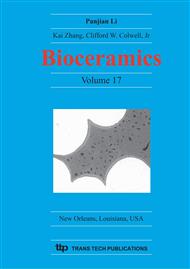p.235
p.239
p.243
p.247
p.251
p.255
p.259
p.263
p.267
In Vivo and In Vitro Studies on the Bioactivity of Anodic Oxidized Titanium Metal
Abstract:
In this study, the bioactivity of a new kind of anodic oxidized titanium metal was investigated in vitro and in vivo. After immersed in SBF solution for 7 days in vitro, apatite formed and covered almost all the surfaces of the anodic oxidized samples. In vivo animal experiment, the apatite was also tested precipitated on the interface of tissue/materials after 12 weeks post-operation, and there were no any fibrous capsule formed around the materials. The materials bonded with the bone very tightly and attached to the skin very closely, which would result in the achievement of the biological sealing for the bone-anchored percutaneous implants. These positive results might be contributed to the precipitated apatite layer formed on the surface of the bioactive oxidized titanium. Thus, Anodic oxidation treatment might be an effective way to prepare bioactive Ti both for bone replacement and percutaneous implant.
Info:
Periodical:
Pages:
251-254
Citation:
Online since:
April 2005
Authors:
Keywords:
Price:
Сopyright:
© 2005 Trans Tech Publications Ltd. All Rights Reserved
Share:
Citation:


